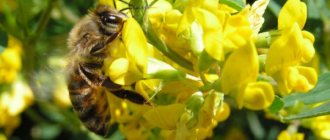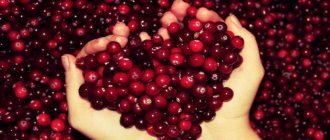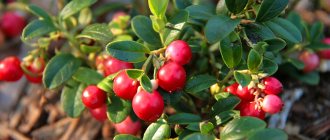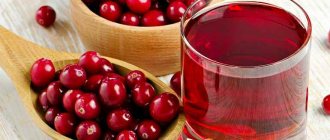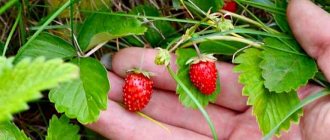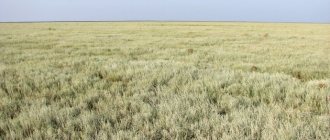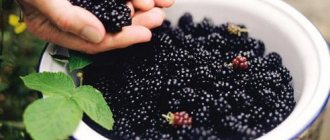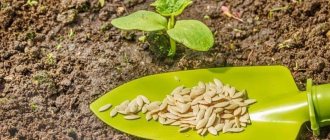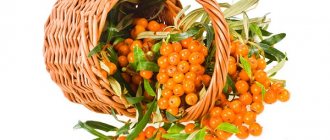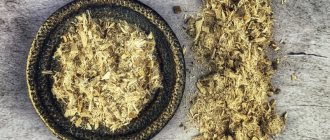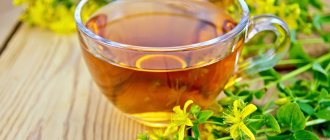What is healthier - cranberries or lingonberries?
Since ancient times, in folk medicine, cranberries and lingonberries have been used as a means to heal mechanical damage, brewed as cough tea, and medicinal decoctions and infusions made from them. The range of beneficial properties of these berries is much wider than most people think. Cranberry has the following properties:
- Fights viruses.
- Reduces temperature.
- Helps antibiotics cope with the disease.
- Kills germs.
- Helps cure diseases of the genitourinary system.
- Normalizes blood pressure levels.
- Promotes smooth functioning of the digestive system.
- Reduces the amount of “bad” cholesterol in the blood.
- Improves the functioning of the cardiovascular system.
- Eliminates rheumatism.
- Fights all colds.
- Improves appetite.
- Stimulates mental abilities.
Lingonberry is not inferior to its rival in its beneficial properties. It has the following effects on the body:
- Fights viruses.
- Has antipyretic properties.
- Helps eliminate problems of the genitourinary system.
- Prevents the appearance of kidney stones.
- Removes toxins from the body.
- Strengthens membrane walls.
- Fights rheumatism.
- Eliminates harmful microorganisms.
- Helps lower blood pressure.
- Reduces blood cholesterol.
- Resists the formation of fatty deposits in the liver.
- Struggling with poor health after alcohol intoxication.
Only lingonberries and cranberries have this set of necessary components that affect the body. A comparison of the beneficial and medicinal properties of these berries will not be complete if contraindications to the use of plants are not taken into account.
Contraindications to eating berries
Cranberries and lingonberries are a treasure trove of nutrients. Regular consumption of berries and juices restores the body's functioning and improves general condition. However, there are diseases for which these fruits are contraindicated:
- increased stomach acidity;
- inflammatory liver diseases;
- exacerbation of stomach and duodenal ulcers;
- low blood pressure.
All people can enjoy these fruits, but they must be consumed in large quantities with caution. Before starting treatment with berries, you should consult a doctor, he will be able to advise acceptable dosages and the best therapy.
For what diseases are cranberries used, and for what diseases are lingonberries used?
Lingonberry, namely its leaves, has a pronounced diuretic, anti-inflammatory and antiseptic effect on the organs of the genitourinary system. The raw materials contain up to 9% arbutin, a substance that helps destroy pathogenic microorganisms on the surface tissues of the bladder and urinary tract. Due to these properties, preparations based on lingonberry leaves are prescribed in complex therapy:
- Cystitis;
- Urethritis;
- Prostatitis;
- Some kidney diseases (mild pyelonephritis, sand in the kidneys);
- Edema.
Lingonberry leaves also have an astringent effect, due to which in traditional medicine their preparations are prescribed for stomach disorders.
In folk medicine, decoctions, infusions and teas from leaves are recommended for a wider range of diseases, namely:
- Gout;
- Arthritis;
- Osteochondrosis;
- Diabetes mellitus;
- Digestive disorders;
- Gastritis;
- Pancreatitis;
- Liver diseases;
- Sore throat;
- Thrush;
- Mastopathy and other diseases.
The effect of lingonberry berries on the human body differs from the effect of leaves. They do not contain such amounts of arbutin and some other substances, which is why the diuretic and antiseptic effects, although manifested, are to a much lesser extent. At the same time, there are specific indications for the use of berries, when the use of plant leaves, on the contrary, is less effective.
Thus, preparations from lingonberry fruits are used for:
- Feverish syndrome, as they enhance the effect of antipyretics by stimulating diuresis;
- High blood pressure and resulting headaches, as medications help lower it;
- Hypovitaminosis, since the fruits contain many vitamins.
Cranberry juice is used in almost the same cases as lingonberry juice.
Cranberry juice is used more often in cooking - it contains more fiber than juice.
The effectiveness and benefits of lingonberry and cranberry fruits are similar. Moreover, in cases where there are indications for the use of lingonberry leaves, it is impossible to replace them with the fruits of one of the plants or the leaves of another. The properties of cranberry leaves have been little studied and are not used in traditional medicine.
How to distinguish cranberries from lingonberries
Both plants belong to the heather family and are low-growing, creeping shrubs, rarely reaching 30 cm in height. The leaves of cranberries and lingonberries do not fall off in winter and have a hard, glossy surface. Nevertheless, the difference between cultures can be traced to many factors, one of them is habitat.
Lingonberry or boletus, as the name suggests, prefers forests. The berry grows best in the partial shade of coniferous thickets, but is found throughout deciduous and mixed forests. Lingonberry survives well from the tundra to mountainous regions, gravitating more towards the north.
The difference between cranberries is that they love water, preferring flooded places with acidic, moist soil. It grows well in swamps, forming scatterings of bright, red beads. Cranberries are found in moist mosses throughout the Northern Hemisphere; the Russian range extends to the Arctic Ocean. Unlike lingonberries, the swamp beauty tolerates the warm European climate well. Wild cranberries can be found all the way to the Black Sea coast.
Differences between cranberries and lingonberries:
- Fruit size. Cranberries are much larger, the diameter of wild berries reaches 12 mm, cultivated varieties - up to 20 mm. Lingonberry, in contrast, grows up to 0.8 cm.
- The shape of the fruits of both crops is spherical. The cranberry resembles a very small pomegranate, and the tip of the lingonberry is slightly pressed inward.
- Taste. Cranberries are less sweet and contain up to 4% acids; lingonberries contain no more than 2%. Sugars 6 and 12% respectively.
- Appearance of the bush. Lingonberry is a low, creeping, but clearly distinguishable bush. Cranberries preferably grow deep in moss. Often only bright fruits and the tips of young shoots are visible on the surface.
The external differences between cranberries and lingonberries are clearly visible in the photo. Taste benefits should be compared based on personal experience. The rich chemical composition of related plants has significant differences.
Differences in the appearance of bushes
Also, lingonberries are quite clearly different from cranberries in the appearance of the bushes. Both species have a life form that is a herbaceous shrub, but both have clear distinctive features. If lingonberry bushes are very short and seem to creep along the ground, having a height of 10-15 cm, then cranberry bushes are taller. Cranberry shoots stretch upward, and those parts of them where the fruits ripen generally stand upright. As a result, the cranberry bush reaches a height of 15-30 cm.
The flowers of these plants differ even more clearly. In lingonberries, they hang together in 3-4 flowers, as if covered with dense shiny leaves on top. Cranberries have flowers on tall stems that bend like the neck of a crane. This is partly why in English cranberries are called Cranberry - “crane berry”, and in Ukrainian - simply “crane”.
In the photo below you can see lingonberry flowers:
And here are cranberry flowers:
There is also a significant difference: lingonberry flowers are collected in small groups of 3-4 flowers, due to which later the berries ripen in such “packs”. In cranberries, each flower is located on its own stem, and therefore all the fruits are later located singly, apart from each other.
It is also useful to read: Useful properties of lingonberries
Finally, let us once again pay attention to the leaves: in cranberries they are small, much smaller than berries, and in lingonberries they are larger than the berries.
Cranberry berries and leaves
Lingonberry berries and leaves
Difference in composition and calorie content
Lingonberries and cranberries can be safely classified as unique vitamin complexes created by nature. In terms of the content of valuable nutrients and vitamins, wild berries are superior to any pharmaceutical preparations.
The main valuable substances of cranberries:
- vitamin C – more than citrus fruits;
- vitamin K – more than in cabbage;
- a full range of B vitamins;
- nicotinic acid (PP);
- organic acids, the most valuable: ursolic and citric;
- almost all microelements needed by the body, including iron, copper, chromium, zinc.
With an equally wide range of useful substances, lingonberries have several differences in the composition of elements and their quantity.
Boron berries are especially rich in the following useful compounds:
- magnesium, which is rarely found in such concentrations;
- calcium, potassium, iron, phosphorus;
- the whole complex of “beauty” vitamins: A, C, E, riboflavin;
- organic acids, the most valuable of which are benzoic, citric, malic;
- pectins, tannins.
Both berries are beneficial for the human body, as they restore the functioning of organs and systems. Lingonberries and cranberries differ from each other not only in appearance, but also in their composition and calorie content. Lingonberries contain the following important components:
- niacin (vitamin PP);
- vitamins C, B, E, K;
- mineral salts;
- tannins;
- phosphorus, calcium;
- disaccharide
Thanks to this composition, 100 g of berries contain 43 kcal, since they contain more sugars. The chemical composition of cranberries is a real storehouse of useful substances. The fruit has a completely different composition, it includes the following substances:
- iron, sodium;
- a nicotinic acid;
- vitamins B, C, K;
- iodine, magnesium;
- potassium, organic acids.
How to distinguish between cranberries and lingonberries
For those who often pick lingonberry and cranberry berries, it is not difficult to distinguish them externally from each other. This can also be easily done by an inexperienced consumer, knowing only the main distinguishing features of these two forest crops.
Fresh
Fresh lingonberry and cranberry fruits differ in the following characteristics:
- cranberries taste sweet and sour, and lingonberries are much sour and have a slight bitterness;
- cranberry fruits are large, juicy, and release juice when pressed; lingonberry fruits are much smaller in size, their pulp is dense, and the juice is squeezed out with difficulty;
- the color of cranberries is darker than that of lingonberries;
- the shape of the cranberry fruits looks like a pomegranate, and the boletus has a small dent.
Find out how lingonberries affect a person's blood pressure.
Frozen
When frozen, the fruits of forest crops also have some differences. For example, frozen cranberries are able to retain their beneficial substances, their taste becomes sweeter, and the appearance of the berries does not lose their marketability. But after defrosting, frozen boletus berries become watery and cannot be transported anywhere.
From the above it follows that despite the fact that forest berry bushes belong to the same family, there is a significant difference between them both in appearance and in chemical composition. The most important thing is that the fruits of both plants bring great benefits to the human body, and their use is recommended by experts.
What is healthier for colds and respiratory diseases?
Despite the widespread use of cranberries and lingonberries in folk medicine for the treatment of ARVI and acute rhinitis (colds), there is no convincing evidence that any use of both the fruits of these plants and the same lingonberry leaf can provide a pronounced therapeutic effect. None of these remedies can affect the cause of a viral disease or can destroy a bacterial infection that develops in the tissues of the mucous membrane of the nasal passages.
The berries themselves and drinks made from them can be used as sources of vitamins for the patient and to quench thirst during fever. But in this regard, both cranberries and lingonberries are almost equally effective and there are no differences between them as between sources of vitamins.
The video below shows how to properly prepare such a vitamin drink:
There is also an opinion among people about the benefits of lingonberry and cranberry drinks for reducing the temperature of a patient. In reality, this effect of these drugs is very weakly expressed, since they are not able to influence the causes of temperature, do not have a pronounced anti-inflammatory effect, and influence the temperature only due to the fact that they provoke the removal of a large amount of fluid from the body and are themselves a source of such fluid. As a result, if you drink pharmaceutical antipyretics, and additionally drink drinks based on lingonberries or cranberries, the effect of antipyretics will be more pronounced, the temperature will decrease to a greater extent and for a longer period.
By themselves, neither cranberries or lingonberries, nor lingonberry leaves reduce the temperature. It is impossible to say that these remedies somehow “bring down” the temperature quickly or for a long time.
Therefore, it makes no sense to use them as powerful and effective antipyretics, and in addition to traditional drugs based on ibuprofen and paracetamol, they can be used with equal effectiveness
It doesn’t matter whether the patient drinks lingonberry or cranberry juice after taking an antipyretic - the effect will be the same in both cases
Finally, for the treatment of cough, both lingonberries and cranberries are equally of little use. They do not have any pronounced effects, do not increase cough productivity and do not help cleanse the lungs. In fact, the berries of these plants do not help with diseases of the lower respiratory tract
Therefore, it does not matter what specific drugs the patient decides to use - they will not have the same effect on cough
Difference in chemical composition
Both berries are of great benefit to humans, but the chemical composition is still slightly different. very important components:
- vitamins C, A, B, E, K, PP;
- acids: nicotinic, ursolic, tartaric, benzoic;
- tannins;
- pectin;
- minerals;
- phosphorus and calcium;
- copper;
- disaccharide;
- essential oils.
No less than lingonberries. The berry contains the same set of vitamins, but vitamin C predominates. Minerals that can be identified are those that are not found in lingonberries: barium, iodine, magnesium. There is iron, calcium, silver, magnesium. Therefore, having studied the composition superficially, without going deeper, answer the question “what is healthier than cranberries or lingonberries?” It is impossible to answer unequivocally.
Let's consider the differences between berries according to their properties that they have on the human body. Even if there is a difference in properties, this indicator is not important for traditional healers, since both plants are valued equally.
Since ancient times, decoctions and infusions have been used as wound-healing, antiseptic, and anti-inflammatory agents. Often, potions were prepared using medicinal raw materials from both shrubs. Let's look at what was treated with each berry separately.
Cranberry
The berries can be used to prepare an antiviral agent used for acute respiratory infections and colds. It can lower body temperature, relieve chills and alleviate feverish conditions.
- Used as a diuretic and diaphoretic, applied.
- The pureed mass can be used to relieve pain and heal purulent wounds.
- Reduces blood cholesterol levels.
- In terms of ascorbic acid content, it is second only to lemon, which means it can combat autumn vitamin deficiency.
- Destroys some cancer cells (stomach).
- Used for diabetes.
- Normalizes the functioning of the heart and blood vessels.
Cranberry fruit drink and juice are used for burns and headaches. Delicious drinks will give you energy and strength and quench your thirst. Very often, cranberries can be found in medicines and preparations sold in pharmacies. They help with pyelonephritis, cystitis and other infectious diseases of the human genitourinary system. Helps with stomach and intestinal ulcers.
With regular consumption of berries per day, you can say goodbye to varicose veins and thrombophlebitis, as the walls of blood vessels become elastic and strong.
Cowberry
The berry has an antiscorbutic effect and also copes with oral problems: sore throat, gingivitis, stomatitis, bad breath.
- Has an antimicrobial effect on the bladder and genitals.
- Used for prophylaxis in the fight against kidney stones.
- It is an anti-inflammatory agent for diseases of the upper respiratory tract: cough, bronchitis, tracheitis.
- Used to relieve the condition during a terrible hangover.
- It has a beneficial effect on the functioning of the liver, gastrointestinal tract, kidneys, and heart.
- Strengthens the walls of blood vessels, which...
- Actively used by athletes to strengthen muscle and bone tissue.
- Removes toxins and alcohol breakdown products.
In addition to the above, lingonberry stems and leaves are endowed with benefits, which are popular in pharmacology. Strengthens the immune system, replenishes the deficiency of vitamins and microelements in the body, has a beneficial effect on the organs of vision, is used for anemia and neuroses - all this is lingonberry. In addition to the above, it is a tasty treat for children and adults.
Having studied the beneficial properties, it is impossible to single out one berry over another or affirmatively state that it is better for a cold or other illness. Both are popular among culinary specialists and traditional healers, and are also included in the composition of traditional medicines.
What is the difference?
Cranberries and lingonberries are forest dwellers, but they choose different places to grow. Cranberries prefer to grow in peat bogs, acidic and swampy soil, and lingonberries love coniferous forests, where the ground is dark, and even better - damp lowlands. It can be found in the tundra and subarctic. No wonder it is called the northern berry. Cranberries can be found not only in the North, but also in the Volga region, Crimea and the Carpathians.
Characteristics
It is very difficult to confuse these two berries, since in appearance they are similar except in color, but they differ in size, shape and the bush on which they grow. Lingonberries are much smaller in size than cranberries; they can also be distinguished by the fact that they grow on tassels located on thin stems. This is a herbaceous plant that does not reach a height of 30 centimeters. In winter, lingonberries sit firmly on the branches and serve as food for forest birds.
After frost, in the spring, the berries acquire a special taste and aroma; during this period they contain the maximum concentration of vitamins and nutrients.
Lingonberries do not grow near large cities and industrial centers, as they prefer ecologically clean areas, so you will have to leave the city a fair distance to collect them.
Cranberries can be visually compared to pomegranates; they look like this southern fruit, only in miniature. Unlike lingonberry, a herbaceous plant, it grows on a bush, which, due to climatic conditions, spreads along the ground. It gains color in late spring - early summer (this depends on the latitude of growth). Cranberry buds are very beautiful and resemble pink bells.
Read also: How to prune blueberries correctly
The fruits begin to ripen by mid-autumn. Ripe berries have a rich red color and tart aroma. Each bush is literally strewn with berries - several liters of fruit can be collected from one plant. Cranberries are spread by birds, who eat them, but do not digest the seeds, and they naturally leave their bodies.
Compound
Both cranberries and lingonberries have a very rich composition; in terms of the content of vitamins and microelements, they can give odds to many recognized medicines. For example, cranberries contain more vitamin C than lemons, and more vitamin K than cabbage. Cranberries are also rich in vitamins B and PP. Of the acids, it contains oleic, quinic, citric oxalic and some others, but in smaller quantities. Among the trace elements in the composition you can find iron, copper, manganese, chromium, zinc, aluminum.
Lingonberries are the record holder for magnesium content. It is often recommended for pregnant women with late gestosis and the development of edema, since the berry has a pronounced diuretic effect. Lingonberries are also rich in other microelements - potassium, calcium, phosphorus, and iron can be found in its composition. It also contains vitamins A, B2, C, E.
Beneficial features
It is noteworthy that in lingonberries all parts of the plant are used for medicinal purposes, while in cranberries only the fruits are used. Thus, lingonberry leaves and shoots have a pronounced diuretic and antiseptic effect. Their infusion is used during epidemics as a prophylactic agent, and in case of viral and bacterial infections - as a means of maintaining immunity.
When taken regularly, this infusion has a therapeutic effect for joint diseases, gout and arthritis. This property is due to the ability of such tea to remove toxins and heavy metal salts from the body.
For kidney disease and urolithiasis, it is useful to eat fresh lingonberries. They contain tannins, which help support kidney function by helping to break down stones and remove sand from them. Also, fresh or soaked berries have an antiseptic effect for inflammatory diseases of the genitourinary system, help relieve inflammation and fight pathogens, prevent their spread and act as a natural antibiotic.
Inflammatory diseases of the upper and lower respiratory tract are also an indication for the use of lingonberries as an adjunct to drug therapy. Bronchitis, pneumonia, sinusitis and pharyngitis - this healing berry will help you cope with all of this.
Cranberry is an excellent natural medicine for hypertensive patients. Thanks to the microelements it contains, it can influence cholesterol levels in the blood and strengthen the walls of blood vessels. In addition, it is able to increase the level of hemoglobin in the blood, since it contains a sufficient amount of iron, which is absorbed almost completely due to its unique composition.
The set of vitamins of this berry has an immunostimulating and supportive effect on the body during infectious diseases. For ARVI and influenza, it is recommended to eat a handful of cranberries daily to prevent vitamin deficiency.
It is best to consume this berry fresh, as it retains the maximum amount of nutrients.
The large amount of fiber in the composition has a positive effect on the functioning of the gastrointestinal tract, in particular on intestinal motility. For constipation, regular consumption of this berry can normalize stools and facilitate the passage of gas during bloating. Cranberries can also speed up metabolism and accelerate the burning of carbohydrates, thereby promoting faster weight loss. In terms of usefulness for weight loss, the berry outperforms many popular dietary supplements that are so actively advertised.
Cranberries and lingonberries are two berries that are considered wonderful and healing for their benefits. They both taste sour and are quite difficult to eat raw, but compotes, fruit drinks, and preserves turn out simply delicious! Despite the obvious properties, herbalists know very well how cranberries differ from lingonberries and know how to find different uses for the berries, store them, and prepare them for future use. Let's consider how cranberries and lingonberries differ from each other, and whether it is possible to distinguish the berries by type, shape, and place of growth.
Beneficial features
Benefits of lingonberries
The question of which berry is more useful is not entirely correct. Shrubs are closely related plants, but not the same. When talking about their health benefits, one must first take into account the fact that lingonberry leaves are most often used for treatment, not berries, while for cranberries, on the contrary, mainly only the fruits are used.
Lingonberry leaves contain a number of substances that are not found in the fruits of both plants. In particular, they contain up to 8% arbutin, a substance that provides a diuretic and antiseptic effect on the organs of the genitourinary system. Because of this, decoctions and infusions of leaves have a stronger effect than any preparations from the fruit.
Lingonberry tea made from brewed leaves
Accordingly, if a doctor has prescribed you to take a decoction of lingonberry leaves, then you cannot replace it with a medicine made from cranberry leaves or their fruits. If you cannot find a remedy, you should consult a doctor so that he can recommend another one.
In cases where the fruits of one of the plants are used, their replacement is, in principle, acceptable. However, it must be taken into account that the composition of the berries, although very similar, is still not the same. Thus, a doctor must evaluate the advisability of taking a particular drug.
Cranberries are more common and the conditions for collecting them on an industrial scale are simpler. Because of this, you can often find fruit drinks and other cranberry drinks in stores, while lingonberry drinks are quite difficult to find. Because of this, it may seem that the first ones are more useful, but in fact this is not the case.
Cranberries and lingonberries are different plants, so it is incorrect to compare which fruit is more useful. Their taste qualities also differ, due to which they are used in cooking in different ways. In cases where drugs based on lingonberries or cranberries are used for medical purposes, one cannot be replaced with the other, as this may reduce the effectiveness of treatment or provoke side effects.
The unique concentration of vitamins allows both plants to be used to prevent and treat vitamin deficiency. High iron content helps increase hemoglobin. The most valuable remedy would be a lingonberry-cranberry cocktail, as it combines the healing properties of crops.
Lingonberry is a berry similar to cranberry, but their chemical composition is not identical. Existing differences affect the area of use of fruits.
Medicinal properties of cranberries:
- Reduced blood pressure in hypertension.
- Strengthening the walls of blood vessels, reducing cholesterol deposits.
- Immunostimulating, restorative effect during infections, during periods of recovery after illness.
- Normalization of the gastrointestinal tract in case of bloating, constipation, diseases with reduced acidity.
- Accelerates metabolism, activates the breakdown of carbohydrates, which promotes weight loss.
Use of lingonberries for healing the body:
- During influenza epidemics, taking lingonberry decoctions, juices and teas is an effective prevention.
- To increase the body's defenses, the plant is indicated for viral and bacterial infections.
- In the treatment of inflammation of the genitourinary system, stone formation, chronic cystitis, pyelonephritis, it is used as an addition to the main therapy in consultation with a doctor.
- Helps in the treatment of sinusitis, pharyngitis, inflammation of the bronchi and lungs.
- Recommended for joint diseases, arthritis, gout.
It is impossible to accurately assess which is healthier, cranberries or lingonberries, because they can be used for completely different problems in the body. When treated with folk remedies, the differences between plants are especially noticeable. But for prevention or general support of a weakened body, both lingonberries and cranberries are suitable.
Beneficial features
Let's consider the differences between berries according to their properties that they have on the human body. Even if there is a difference in properties, this indicator is not important for traditional healers, since both plants are valued equally.
Since ancient times, decoctions and infusions have been used as wound-healing, antiseptic, and anti-inflammatory agents. Often, potions were prepared using medicinal raw materials from both shrubs. Let's look at what was treated with each berry separately.
Cranberry
The berries can be used to prepare an antiviral agent used for influenza, acute respiratory infections, and colds. It can lower body temperature, relieve chills and alleviate feverish conditions.
- Used as a diuretic and diaphoretic, used to treat cystitis.
- The pureed mass can be used to relieve pain and heal purulent wounds.
- Normalizes blood pressure.
- Reduces blood cholesterol levels.
- In terms of ascorbic acid content, it is second only to lemon, which means it can combat autumn vitamin deficiency.
- Destroys some cancer cells (stomach).
- Used for diabetes.
- Normalizes the functioning of the heart and blood vessels.
Cranberry fruit drink and juice are used for burns and headaches. Delicious drinks will give you energy and strength and quench your thirst. Very often, cranberries can be found in medicines and preparations sold in pharmacies. They help with pyelonephritis, cystitis and other infectious diseases of the human genitourinary system. Helps with stomach and intestinal ulcers.
With regular consumption of berries per day, you can say goodbye to varicose veins and thrombophlebitis, as the walls of blood vessels become elastic and strong.
Cowberry
The berry has an antiscorbutic effect and also copes with oral problems: sore throat, gingivitis, stomatitis, bad breath.
- Has an antimicrobial effect on the bladder and genitals.
- Used for prophylaxis in the fight against kidney stones.
- It is an anti-inflammatory agent for diseases of the upper respiratory tract: cough, bronchitis, tracheitis.
- Used to relieve the condition during a terrible hangover.
- It has a beneficial effect on the functioning of the liver, gastrointestinal tract, kidneys, and heart.
- Strengthens the walls of blood vessels, which normalizes blood pressure.
- Actively used by athletes to strengthen muscle and bone tissue.
- Removes toxins and alcohol breakdown products.
In addition to the above, lingonberry stems and leaves are endowed with benefits, which are popular in pharmacology. Strengthens the immune system, replenishes the deficiency of vitamins and microelements in the body, has a beneficial effect on the organs of vision, is used for anemia and neuroses - all this is lingonberry. In addition to the above, it is a tasty treat for children and adults.
Having studied the beneficial properties, it is impossible to single out one berry over another or affirmatively state that it is better for a cold or other illness. Both are popular among culinary specialists and traditional healers, and are also included in the composition of traditional medicines.
Lingonberry and cranberry leaves
Cranberry leaves are oblong or ovate with a short petiole, length from 3 to 15 mm, width from 1 to 6 mm.
These are some of the differences that exist between such similar berries - cranberries and lingonberries. In general, both of them are useful and are a real source of vitamins for our body!
Cranberries and lingonberries are tasty and healthy berries that belong to the same heather family. Under natural conditions, they can often be found very close to each other, but cranberries love swampier soil, and lingonberries grow on dry hills. What is healthier – cranberries or – you can find out from this article.
Beneficial properties of cranberries and lingonberries
Cranberries taste sour, they contain more acids, but less sugar. Lingonberries are sweeter than cranberries, smaller in size and have a denser structure, as well as a flattened shape. It is impossible to say unequivocally which is better - lingonberries or cranberries. Both berries have a huge supply of vitamins, minerals and other valuable substances. Cranberries contain a lot of vitamin C, as well as K, PP and group B. Among the mineral substances, barium, potassium, iodine, magnesium, etc. can be distinguished. Lingonberry is practically in no way inferior to it and also includes a huge variety of nutritional components - iron, calcium, potassium, manganese, as well as organic acids - tartaric, benzoic, salicylic, etc.
Many people are interested in what is better to eat for a cold – cranberries or lingonberries, but this question cannot be answered unequivocally. Both berries have been used since ancient times as an antipyretic, diaphoretic, antiviral and antibacterial agent. To treat colds and flu, you can successfully use either one or both at once. Drinking cranberry or lingonberry juice for a cold will boost your immunity and speed up recovery. Cranberries are useful for cardiovascular diseases and rheumatism, and lingonberries have proven themselves in the treatment of genitourinary diseases, in particular cystitis.
Both berries have a low calorie content: lingonberries contain 43 kcal, and cranberries - 26 kcal, so taking both is not contraindicated for obesity, and even moreover, they prevent the deposition of fat in the liver and harmful cholesterol on the walls of blood vessels. True, due to the abundance of acids in berries, they are not recommended for use by persons with diseases of the gastrointestinal tract - gastritis and ulcers. It is also necessary to remember that they are capable of absorbing poisons and toxins from the environment well, so they can only be collected in environmentally friendly areas. Frozen, they do not lose their healing properties and can be used both for direct consumption and for making compotes, fruit drinks, jam, etc.
In the article we discuss what is healthier - cranberries or lingonberries, methods of preparing and storing them, and use during pregnancy. You will learn what diseases and conditions the berries are used for, their similar properties and differences.
Cranberries or lingonberries - which is more useful to use, and are there any differences in their composition? Both berries are similar in appearance - they are spherical in shape and red in color. What is larger - lingonberries or cranberries? Cranberries are much larger in size. It grows in swamps and acidic peat soils, and lingonberries are collected in coniferous and mixed forest zones, in lowland and mountain tundras, and in arctic areas. Appearance (photo) of cranberries Useful properties of cranberries:
- Diuretic - the berry is used for diseases of the urinary tract, cystitis, urethritis, and kidney pathologies.
- Anti-inflammatory - thanks to the high content of phytoncides and bioflavonoids, cranberry eliminates foci of infection, helps reduce swelling and rapid tissue regeneration.
- Antiscorbutic - strengthens the immune system and restores the balance of beneficial microflora.
- Hypotensive - cranberry lowers blood pressure.
- Secretory - cranberry juice increases the secretion of gastric and pancreatic juice, promotes rapid and complete absorption of food, and normalizes intestinal motility.
Cranberry also reduces the symptoms of skin diseases. The berry is used for allergic rashes, psoriasis, vitiligo, and focal alopecia (baldness).
Cranberries contain a large amount of vitamin C, organic acids, pectins and cahetins
Sour cranberry juice should be consumed with great caution in case of increased stomach acidity. Its use is contraindicated for stomach and duodenal ulcers
Lingonberries and cranberries: differences and beneficial properties
Despite all the similarities between cranberries and lingonberries, there are still differences between them. Let's look at the characteristics of each berry. Let's try to figure out how lingonberries and cranberries are similar and how they differ.
Titles
Translated from Latin, “cranberry” means “sour ball.” Europeans called it crane berry for the similarity of its flower stalks to a crane’s neck, and in England it was called “bear mountain,” since cranberries, along with wild raspberries, are a favorite treat for clubfooted people. The name “lingonberry” has a solemnly pompous translation - “grape vine from Mount Ida.” In Rus', it has long been called core, brusena, boletus.
Characteristics of the taste of berries
Representatives of the same heather family, cranberries and lingonberries are berries that are not just tasty, but also extremely healthy, although they differ in composition. Cranberries are common in northern and temperate latitudes in marshy, mossy areas.
The sour taste is given to it by the presence of acids in the pulp of the berries in the amount of 3.4% and sugars - 6%. Cranberries can be stored on bushes under the snow, waiting out the long winter, and in the spring they can turn into a full-fledged crop.
Lingonberry, which has a much wider distribution area, is more neutral in taste, it contains less acids (only 2%), and sugars - up to 8.7%. This unpretentious perennial grows in coniferous and mixed forests and is capable of bearing fruit, growing in one place for almost three hundred years. The berries ripen in September.
Cranberries and lingonberries: external differences
Cranberries are slightly larger: dark red, plump, glossy, reaching 0.8-1 cm in diameter, they release juice at the slightest squeeze. Lingonberries are noticeably smaller in size - about 0.6 cm. This burgundy-red color has a slightly flattened shape and a completely different pulp structure: dense, from which it is impossible to get a fountain of juice.
Lingonberries and cranberries, the differences between which we are considering, also differ in foliage. Cranberries have smaller leaves, their length is no more than 1.5 cm, and their width is 0.3-0.6 cm.
Lingonberry bushes are decorated with larger leaves, their length reaches 2-3 cm and width - 1.5 cm. But the shape of the leaves of these plants indicates their family ties and belonging to the same family.
Both species have oval leaves, attached to the stem by short petioles.
Chemical composition
Cranberries are unique in their beneficial properties; it is not without reason that they are considered the healthiest berry, which combines vitamins B, K, C, nicotinic and folic acids, an amazing set of microelements - iron, magnesium, boron, potassium, iodine, calcium, silver, phosphorus, manganese, etc.
The chemical composition of lingonberries, which are not inferior to cranberries in terms of usefulness, is no less diverse. It contains vitamins B, A, E, C, a number of organic acids, such as nicotinic, tartaric, benzoic, ursolic, salicylic, as well as trace elements, valuable mineral salts, pectins and tannins.
Despite some differences in the composition of the berries, it is impossible to judge the level of usefulness of plants such as lingonberries and cranberries. Differences in shape and chemical composition are completely unimportant when it comes to the benefits of these berries. These plants are equally valued by traditional medicine experts.
Useful plants: cranberries and lingonberries
Differences in berries in external characteristics and chemical composition do not affect the recognition of these perennials as the strongest natural antiseptics and antibiotics.
Cranberries and lingonberries have a pronounced anti-inflammatory, antiviral and antipyretic effect.
Aromatic teas made from these berries have long been used by northern peoples as medicines for colds, debilitating coughs, headaches, and kidney stones.
Lingonberry is a well-known antiscorbutic remedy. It, like cranberries, is used in the treatment of bronchitis, colds, and sore throats.
In addition to anti-inflammatory and antimicrobial properties, it has a strong diuretic, antirheumatic and choleretic effect, relieving painful conditions due to urinary tract infections, and normalizes the functioning of the liver and kidneys. Lingonberry fruit drinks help relieve hangover syndrome.
It has been noticed that during pregnancy, both lingonberries and cranberries have undoubted benefits. The differences between these plants are insignificant; together they provide an excellent supply of valuable substances for the mother and unborn child, control the functioning of the bladder, preventing the proliferation of pathogenic microorganisms.
Characteristics of the taste of berries
Representatives of the same heather family, cranberries and lingonberries are berries that are not just tasty, but also extremely healthy, although they differ in composition. Cranberries are common in northern and temperate latitudes in marshy, mossy areas. The sour taste is given to it by the presence of acids in the pulp of the berries in the amount of 3.4% and sugars - 6%. Cranberries can be stored on bushes under the snow, waiting out the long winter, and in the spring they can turn into a full-fledged crop. However, it is slightly inferior to the autumn harvest in terms of ascorbic acid content, but the berries become noticeably sweeter.
Lingonberry, which has a much wider distribution area, is more neutral in taste, it contains less acids (only 2%), and sugars - up to 8.7%. This unpretentious perennial grows in coniferous and mixed forests and is capable of bearing fruit, growing in one place for almost three hundred years. The berries ripen in September.
Wild lingonberry plant
Lingonberry is a wild shrub of the Heather family. It grows up to 25 cm, has a very branched root system, so one shrub can occupy up to 10 square meters. meters of forest or dry swamp.
By age, lingonberries mean the age of the root system, which sometimes reaches three hundred years. It grows underground, branches and comes to the surface with curved stems.
The lifespan of the stems is about four years, half of which they bear fruit, and then, as the leaves fall, they are replaced with new ones.
The leaves are hard, skin-covered and can withstand cold. The color of the leaves is rich, green, and stands out against the background of other forest plants.
The bush blooms in mid-May with small white bell-like flowers. The smell of flowers is weak, so it is quite difficult to determine the type of plant by flowers. At the beginning of August, 2-3 berries appear from each flower cluster.
Lingonberries are green at first, then turn white and turn red. Ripe berries are round in shape, taste sour and bitter, up to 8 mm in size.
They begin to collect from the end of August until the first frost; with early snow cover, it can overwinter under it, retaining its color and smell. It grows in cool areas from Karelia to Sakhalin in pine and mixed forests.
This forest plant also loves peat bogs exposed to sunlight. Moist soil with an acidity pH of 4.0-5.0 is what you need.
It is located at the junction of the Yaroslavl and Kostroma regions. I can recommend it to anyone nearby. Just take a boat to cross Solonitsa.
Here is a photo of lingonberries in the forest, this is how they look at the end of August - in September, when they are all browned.
And here the girl talks in detail about berries and leaves
https://youtube.com/watch?v=42hCVcgGzRI
Contraindications
Despite all the benefits of these fruits, they should be consumed with caution. For example, they are contraindicated for people with high stomach acidity. Cranberry juice, fruit drinks, and fruit compotes are used to treat very young children during colds. However, before feeding your child with them, you should make sure that there is no allergic reaction.
Cranberry juice rarely causes allergies, which is why you can drink it even during pregnancy and breastfeeding. But still, you shouldn’t let your guard down: try 2-3 berries, make sure there is no reaction, and then feel free to drink a glass or more.
I wish you health, delicious and healthy dishes, youth and happiness!
